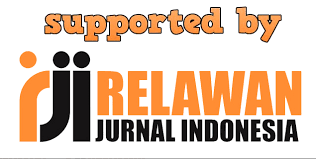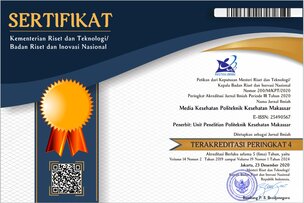Pengaruh Intervensi Gizi Olah Raga Terhadap Kadar Kholesterol, Asupan Karbohidrat, Protein, Lemak Dan Volume Oksigen (VO2)Maksimum Usia Dewasa
Abstract
Gizi olah raga adalah sebuah intervensi gizi kepada subjek yang diteliti selama 2 bulan intervensi berupa pendidikan gizi yang terintegrasi dengan materi kebugaran, aktivitas fisik.Tujuan penelitian ini adalah untuk mengetahui efek intervensi gizi olah raga terhadap pengetahuan gizi, kadar kolesterol, VO2 max, Asupan Karbohidrat, Protein dan Lemak
Metode penelitian ini adalah experiment semu dengan kelompok control. Besar sampel adalah 7 orang kelompok intervensi dan 13 kelompok control. Penelitian dilakukan di Lapangan Olahraga Jurusan Gizi dan Gedung Olah Raga Sudiang Raya.Intervensi pendidikan gizi dilakukan di Jurusan Gizi selama 6 bulan. Data kolesterol diambil dari darah kapiler menggunakan Human KIT, Data VO2 max diambil dengan test cooper, data antropometri dengan timbangan seca dan stadiometer ketelitian masing masing (0,1 kg) dan (0,1 cm). Data Asupan gizi makro dengan Food Recall dengan Multiple Pass Method, dan Nutrisurvey.Pengolahan data dengan Aplikasi SPSS for windows.
Hasil penelitian adalah pendidikan ayah adalah umumnya tamat SMA pada kelompok intervensi (57,1%) dan Perguruan Tinggi (92,3%) pada kelompok kontrol. Pendidikan ibu juga 57,1% tamat SMA pada kelompok intervensi dan 84% tamat perguruan tinggi pada kelompok kontrol. Status gizi obesitas 85% pada kelompok intervensi dan 69% kurus pada kelompok kontrol. Intervensi gizi olah raga berpengaruh pada perubahan skor pengetahun gizi pada kelompok intervensi dan kontrol masing masing p=0,000 dan p=0,000. Tetapi tidak berbeda pada kedua kelompok diawal maupu diakhir intervensi (p>0,050). Asupan gizi makro (Karbohidrat, Lemak dan Protein) tidak berubah pada kedua kelompok (p>0,050). Kadar Kholesterol Total juga tidak berubah (p>0,050) dengan intervensi gizi olahraga 8 minggu intensitas 3 hari seminggu durasi 1 jam. Volume Oksigen Maksimum (VO2 Maks) berubah secara signifikan pada kelompok intervensi (p=0,002). Kesimpulan intervensi gizi olahraga 8 minggu, intensitas minimal 3 kali dengan durasi minimal 60 menit mampu meningkatkan volume oksigen maksimun. Saran agar intervensi gizi olahraga diteliti lebih lama.References
Abeysekara, S. et al., 2012. A pulse-based diet is effective for reducing total and LDL-cholesterol in older adults.
Ahuja, P. & Bharti, V., 2014. Nutrition Knowledge of Football Players and Formulation of an Effective Nutrition Communication Package. International Journal of Food N, 2(2), pp.63–67.
Annesi, J.J., 2013. Association of multimodal treatment-induced improvements in stress, exercise volume, nutrition, and weight with improved blood pressure in severely obese women. International Journal of Behavioral Medicine, 20(3), pp.397–402.
Balitbangkes, 2013. Riset Kesehatan Dasar Propinsi Sulawesi Selatan 2013 Pertama., Jakarta: Balitbangkes.
Banna, J.C. & Townsend, M.S., 2011. Assessing factorial and convergent validity and reliability of a food behaviour checklist for Spanish-speaking participants in US Department of Agriculture nutrition education programmes. Public health nutrition, 14(7), pp.1165–1176.
Barbara Manilla, Heather H.Keller, M.R.H., 2010. Food Tasting as Nutrition Education. Canadian Journal of Dietetic Practioce and Research, 72(2), pp.99–102.
Barreira, T., Harrington, D. & Katzmarzyk, P., 2014. Cardiovascular health metrics and accelerometer-measured physical activity levels: National Health and Nutrition Examination Survey, 2003-2006. Mayo Clinic proceedings, 89(1), pp.81–6. Available at: http://www.ncbi.nlm.nih.gov/pubmed/24388025.
Bird, S., 2010. Strength Nutrition: Maximizing Your Anabolic Potential. Strength and Conditioning Journal, 32(4), pp.80–86.
Brug, J. et al., 2005. The internet and nutrition education : challenges and opportunities. European Journal of Clinical Nutrition, 59(Supp 1), pp.130–140.
Cavanna, L. & Roth, M., 2010. Eat Well, Be Well Nutrition Education Program: Westchester and Lower Putnam County, New York. Childhood obesity (Print), 6(6), pp.350–353.
Cynthia Strawson, Rhonda Bell, Shaunda Downs, Anna Farmer, Dana Olstad, noreen willows, 2013. Dietary Patterns of Female University Students. Canadian Journal of Dietetic Practice & Research, 74(3), pp.138–142.
Danaher, K., 2014. Nutrition Knowledge and Practices of Varsity Coaches at a Canadian University. Canadian Journal Diet Research, 75, pp.210–213.
Dunneram, Y. & Jeewon, R., 2015. Healthy Diet and Nutrition Education Program among Women of Reproductive Age : A Necessity of Multilevel Strategies or Community Responsibility. Health Promotion Prospectives, 5(2), pp.116–127. Available at: http://dx.doi.org/10.15171/hpp.2015.014.
Falter, R.A. et al., 2011. INSTRUCTIONAL DESIGN AND ASSESSMENT A Service Learning Program in Providing Nutrition Education to Children. American Journal of Pharmaceutical Education, 75(5), pp.1–8.
Freedman, M.R., 2010. Development , Evaluation , and Validation of College Nutrition Environment. Journal of American College Health, 58(6), pp.565–568.
Gibson, J.C. et al., 2011. Education and Training of Sport Dietitians in Canada : A Review of Current Practice. Canadian Journal Diet Research, 72, pp.88–91.
Habibi, E. et al., 2014. Study of the relationship between the aerobic capacity ( VO2 max ) and the rating of perceived exertion based on the measurement of heart beat in the metal industries Esfahan. Journal od Education and Health Promotion, 3(June).
Hu, C. et al., 2009. Evaluation of a kindergarten-based nutrition education intervention for pre-school children in China. Public Health Nutrition, 13(2), pp.253–260.
Isbell, M.G. et al., 2015. Development and Implementation of Client-Centered Nutrition Education Programs in a 4-Stage Framework. American Journal Public Health, 105(4), pp.65–71.
James, C., 2001. Integrating evaluation tools to assess nutrition education. Jornal of Nutrition Educatiob, 33(S2).
Khandelwal, S. & Kurpad, A., 2014. Nurturing public health nutrition education in India. European Journal of Clinical Nutrition, 68(5), pp.539–540. Available at: http://dx.doi.org/10.1038/ejcn.2014.42.
Kicklighter, J.R. et al., 2007. College Freshmen Perceptions of Effective and Ineffective Aspects of Nutrition Education. Journal of American College Health, 59(2).
Kim, M. & Claudia, W., 2003. REAP and WAVE : New tools to rapidly assess / discuss nutrition with patients. The Journal of nutrition, Supplement.
Kostanjevec, S., 2012. Nutrition knowledge in relation to the eating behaviour and attitudes of Slovenian schoolchildren. Nutrition and Food Science, 43(6), pp.564–573.
Lodha, S. & Bharti, V., 2015. Impact of Nutrition Education on Hemoglobin Levels of 6 to 18 Months Infants. International Journal of Food Nutrition and Dietetics, 3(2), pp.51–58.
Lyons, B.P., 2014. Nutrition Education Intervention with Community-Dwelling Older Adults : Research Challenges and Opportunities. Journal Community Health, (39), pp.810–818.
Maclellan, D., Sciences, N. & Edward, P., 2011. Toward Evidence-based , Client-centred Nutrition Education Guidelines : Dietitian and Consumer Survey Results. Canadian Journal Diet Research, 72(3).
Mann, S., Beedie, C. & Jimenez, A., 2014. Differential Effects of Aerobic Exercise , Resistance Training and Combined Exercise Modalities on Cholesterol and the Lipid Profile : Review , Synthesis and Recommendations. Sport Medicine, pp.211–221.
Maughan, R.J. & Shirreffs, S.M., 2012. Plenary Lecture 2 Nutrition for sports performance : issues and opportunities. Proceeding of the Nutrition Society, (July 2011), pp.112–119.
Melo, X. et al., 2011. Comparing several equations that predict peak V O 2 using the 20-m multistage-shuttle run-test in 8 – 10-year-old children. Eur Journal App; Physio, 111, pp.839–849.
Mujika, I. & Burke, M., 2011. Nutrition in Team Sports. Nutrition and Metabolism, 57(suppl 2), pp.26–35.
Nursing, P. & Source, A.H., 2009. FITNESS TEST RESULTS OF HUNGARIAN AND INTERNATIONAL-LEVEL SOCCER REFEREES AND ASSIS. Journal of Strength And Conditioning Research, 23(1).
Papadopoulou, S.K. & Papadopoulou, S.D., 2010. Nutritional status of top team-sport athletes according to body fat. Nutrition and Food Science, 40(1), pp.64–73.
Reis, J.F. et al., 2012. Effects of aerobic fitness on oxygen uptake kinetics in heavy intensity swimming. Eur Journal Appl Physio, 112, pp.1689–1697.
Royall, D., 2015. Nutrtition Support for Athletes. Canadian Journal Diet Research, 76.
Taylor, J.P., Mckenna, M.L. & Butler, G.P., 2010. Monitoring and Evaluating School Nutrition and Physical Activity Policies. Canadian Journal of Public Health, 101.
Torres-mcgehee, T.M. et al., 2012. Sports Nutrition Knowledge Among Collegiate Athletes, Coaches, Athletic Trainers, and Strength and Conditioning Specialists. Journal of Atheletic Training, 47(2), pp.205–211.
Wilund, K.R. et al., 2009. Effects of Endurance Exercise Training on Markers of Cholesterol Absorption and Synthesis. , 8408, pp.545–552.
DOI: https://doi.org/10.32382/medkes.v11i2.225
Refbacks
- There are currently no refbacks.
Copyright (c) 2018 Media Kesehatan Politeknik Kesehatan Makassar
Published By : Poltekkes Kemenkes Makassar
Office : Jl. Wijaya Kusuma Raya No. 46 Banta-Bantaeng, Kota Makassar, Sulawesi Selatan, Indonesia
Email : mediakesehatan@poltekkes-mks.ac.id
Media Kesehatan indexed by :
Protected By  |  |

This work is licensed under a Creative Commons Attribution-NonCommercial-ShareAlike 4.0 International License.




